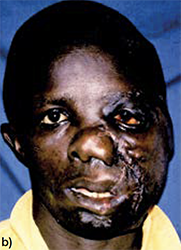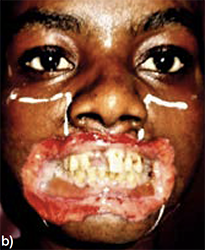Gottfried Lemperle
Christoph Sachs
Katja Kassem-Trautmann
Carsten Schröder
Jörg Kalla
Gottfried Lemperle
Gottfried Lemperle
Katja Kassem-Trautmann, Plastic Surgeon, Zug, Switzerland
Arthur Charpentier1, Gottfried Lemperle2
###
###
###
Katja Kassem-Trautmann, Plastische Chirurgie Zug, Schweiz
Abstract
Surgical interventions in the fiel of cosmetic surgery in developing countries can be particularly effective because such measures do not require elaborate diagnostics: marking, excision, covering of tissue defects with flaps or free grafts; local practitioners usually handle matters of medical aftercare. In this way, surgeons can treat 100 to 200 patients with otherwise limited access to surgical care within a two-week stay. This article aims to present some extreme, yet typical cases of skin tumors.
Keywords: skin tumors, burn contractures, Democratic Republic of Congo, Interplast-Germany
Interplast-Germany e.V. is an association of plastic surgeons who, instead of taking a vacation, spend their free time operating in developing countries where people have no access to surgical care in this specialty. Interplast-Germany was founded 40 years ago in Frankfurt. Now, about 70 teams come together each year, providing surgical care to more than 4,000 patients worldwide during their missions.
Lack of medical care and training in Congo
From a medical point of view, Congo is a neglected country: six times larger than Germany, but with a similar population of 90 million*, it is still at the same level as Europe was 150 years ago. Corruption among those in government and 60 years of civil war have prevented any development and external investment.
There are only a few doctors (1:10,000, or one per 10,000 inhabitants?) and, above all, hardly any surgeons. At most African universities, residents have to pay high fees to be allowed to assist. As a result, benign and malignant tumors in patients in sub-Saharan Africa often grow out of control and kill their carriers.

Interplast operations in Goma
With an Interplast team, we were in Goma, a city of two million on the border with Rwanda, six times between 2015 and 2018. Since we were not allowed to operate in any of the three large local hospitals, we found a blood bank with a poorly equipped operating room without running water and with frequent power outages.


Katja Kassem-Trautmann, Specialist in Plastic, Reconstructive and Aesthetic Surgery (FMH)

Female patient with a unilateral keloid scar after an infected ear stud.

Every morning, up to 200 patients and their relatives were waiting outside the entrance. Depending on the severity of their conditions, we were able to relieve 120 to 200 patients of their external ailments during our 10-day stay. Dedicated medical colleagues assisted us in Goma.
Tumors, burn contractures and tropical infections
The majority of the African patients from Goma have large tumors (bony facial tumors, neck lymphomas, strummas, large keloids), burn contractures and terminal stages of tropical infections. Most of the infants with congenital deformities do not survive. Our most urgent tasks include the removal of monstrous facial tumors, followed by reconstruction, and the treatment of extreme burn contractures.
These contractures occur after third-degree burns, when small children fall into a wood fire or are pushed in by animals. However, second-degree burns are more common, for example when small children pull themselves up on a kettle of boiling water. The world over, the immediate cold water therapy is



Fig. 3 a-c: Two gold miners whose lips were cut off by rebels.
largely unknown, because any water below 37 degrees absorbs the burning heat of over 70 degrees just as quickly from the skin. Where children play, there should be a bucket of water next to every fireplace.1.
Despite the excellent follow-up care provided by local colleagues, we often lack surgical results at a later date, as many patients return to the bush immediately after surgery. Education and prevention could sometimes prevent lifelong disfiguring burn scars. Some striking cases from Congo are presented below. These require a great deal of intuition, flexibility and improvisation under the poor diagnostic and surgical conditions there. However, this is what makes these Interplast missions so interesting and educational.

Case studies
Patient with typical neurofibroma in the face (Fig. 1a, b)
These tumors are among the most difficult to operate on, as they are criss-crossed by a network of heavily bleeding arteries and therefore require aggressive and swift surgery. Unfortunately, the remaining skin in the area is also inelastically altered, meaning that the initially satisfactory result requires further surgery after a few years.

Patient with a unilateral keloid (Fig. 2a)
This patient has a unilateral keloid that has been growing for seven years, but has not grown for two years. Clinically, it is “mature”, that is, no longer taut, but rather impressionable, and can therefore be surgically removed - with triamcinolone in the backhand. The result after one year without recurrence (Fig. 2b) was predictable, since unilateral keloids on the ear do not arise from “predisposition”, but from infections - like all keloids! - and can be safely removed in a “mature” or even “burnt-out” state.2.
Patient with mutilated lips (Fig. 3a-c)
Two private gold diggers who were captured by rebels and denied owning gold. In response, the rebels cut off all eight of their fingers and both ears. When some gold nuggets were found, the rebels also cut off their lips – so they would never be able to lie again. We undermined both cheeks and pulled them together towards the center. The lower lip was created using a reversed visor flap from the neck.3.
Contracted hands in children (Fig. 4a,b)
The body responds to third-degree burns or scalds without skin grafts by causing the surrounding healthy skin to shrink more and more, thereby reducing the size of the burned area. In children, contracted hands can be easily stretched because the bones have not yet fused and the extensor tendons have usually not been burned as well. In developing countries, most cases are primarily second-degree burns that become infected in the following weeks and convert to third-degree defects.



Fig. 5 a-c: Young female patient with unilateral elephantiasis
Female patient with unilateral elephantiasis (Fig. 5a-c)
Young woman with unilateral elephantiasis, probably due to filariae that had entered and multiplied in the lymph vessels. After excision of the entire affected skin, the large defect was covered with meshed split skin, largely from the same lower leg, using the dermatome and a “mesher” that the patient had brought with her.
Conclusion
In developing countries, where there are often no experienced surgeons, skin and bone tumors often grow out of control. Interplast teams operating locally can therefore gain a great deal of experience in a short period of time, including simple reconstruction after the removal of such tumors.
Since further training in plastic surgery is underdeveloped there, Africa will continue to depend on support in the coming decades.
Literature
Correspondence address
Katja Kassem-Trautmann
Fachärztin für Plastische, Rekonstruktive und Ästhetische Chirurgie (FMH)
Bahnhofstrasse 32
6300 Zug, Switzerland
E-Mail: plastische-chirurgie-zug@hin.ch
www.plastische-chirurgie-zug.ch
This article is based on a lecture at the 7th Online-Narbensymposium of Juzo on February 24, 2020